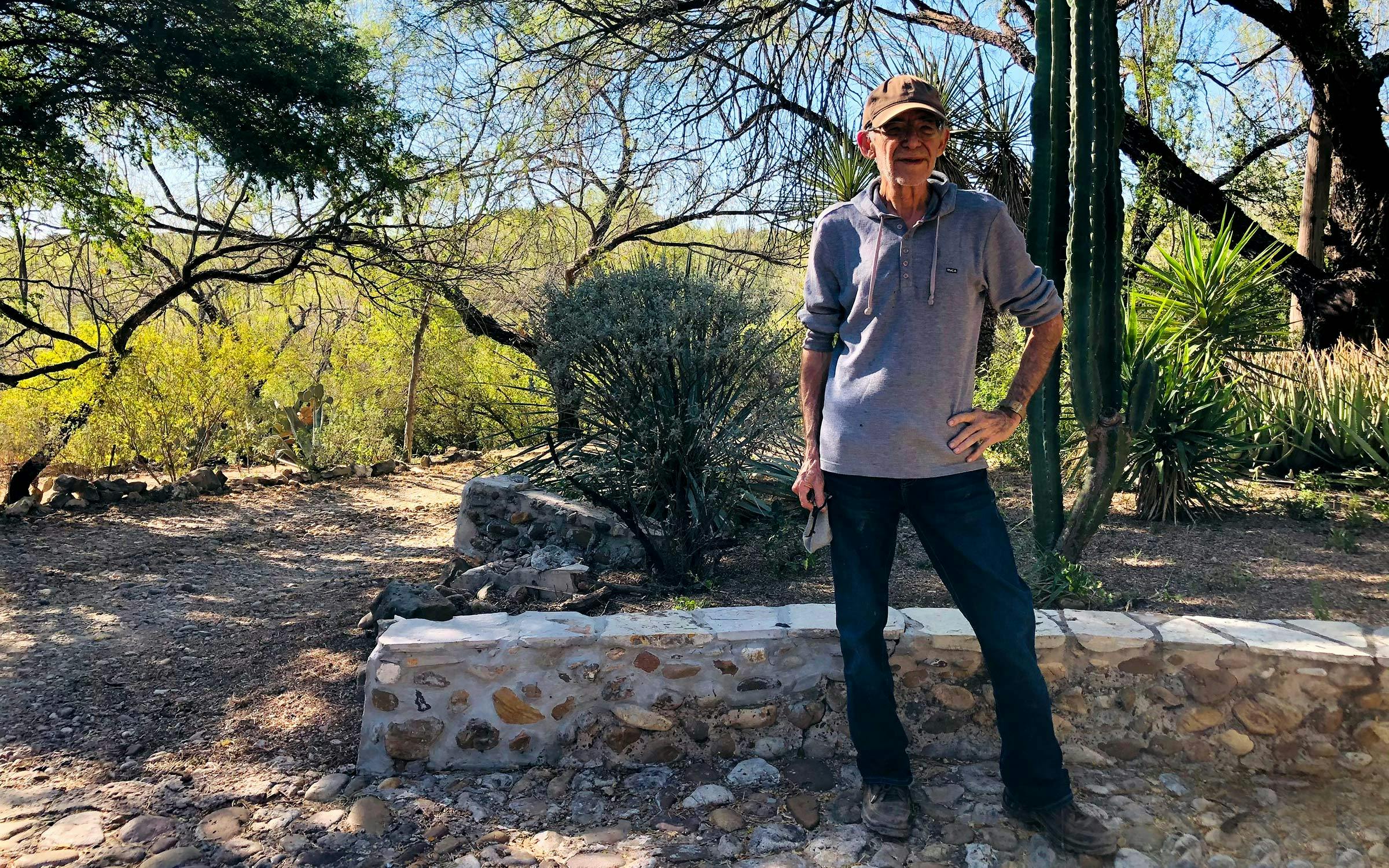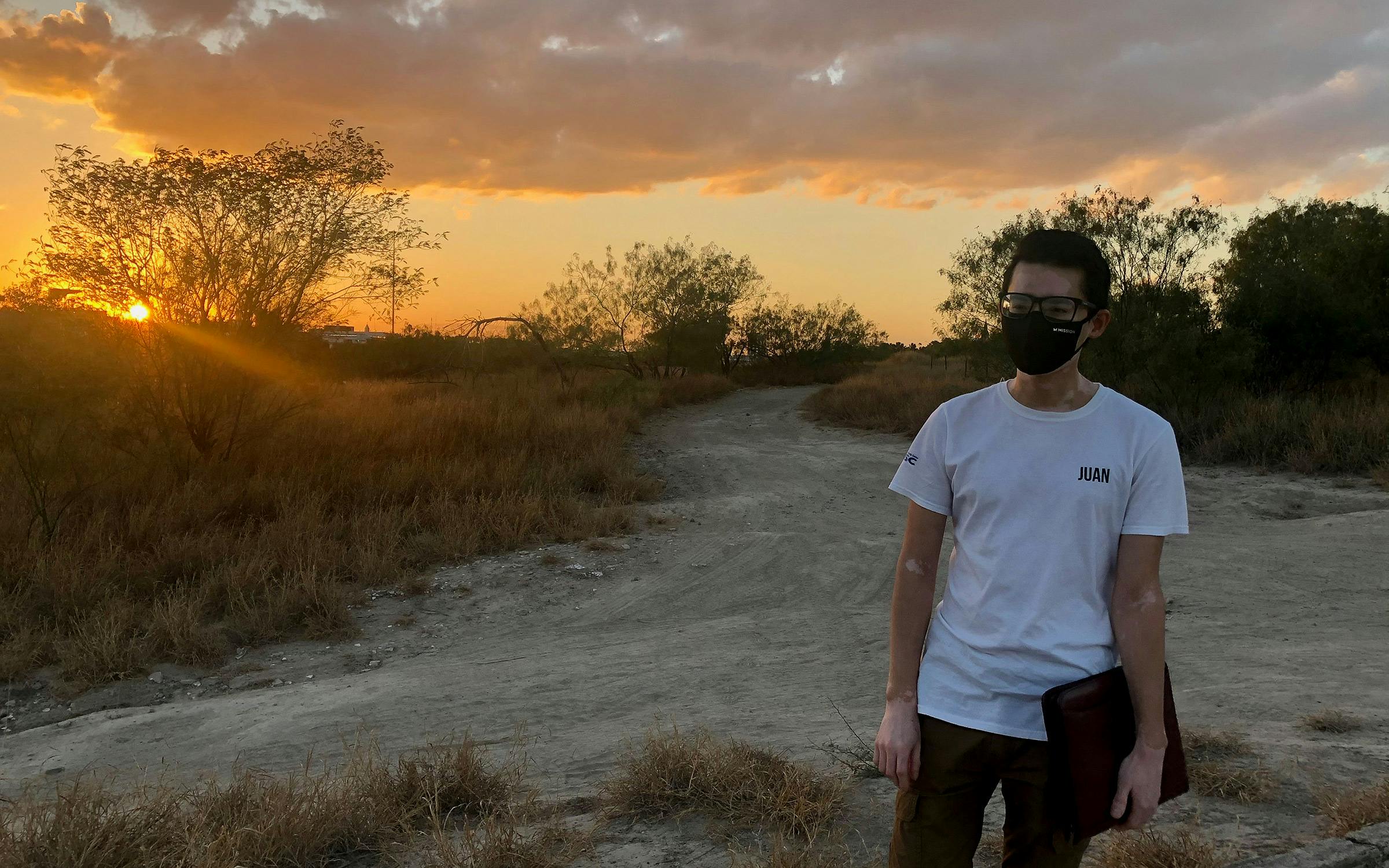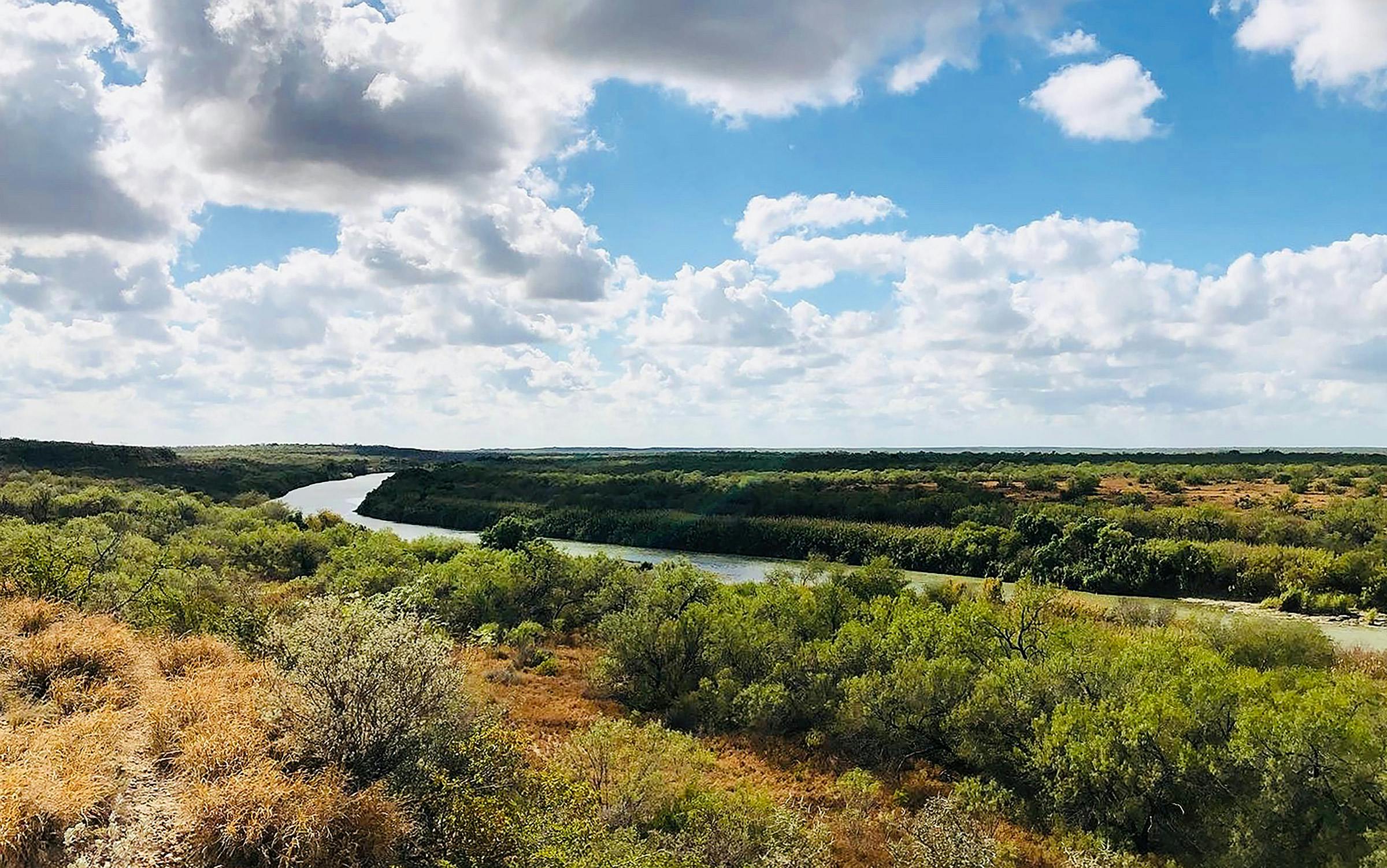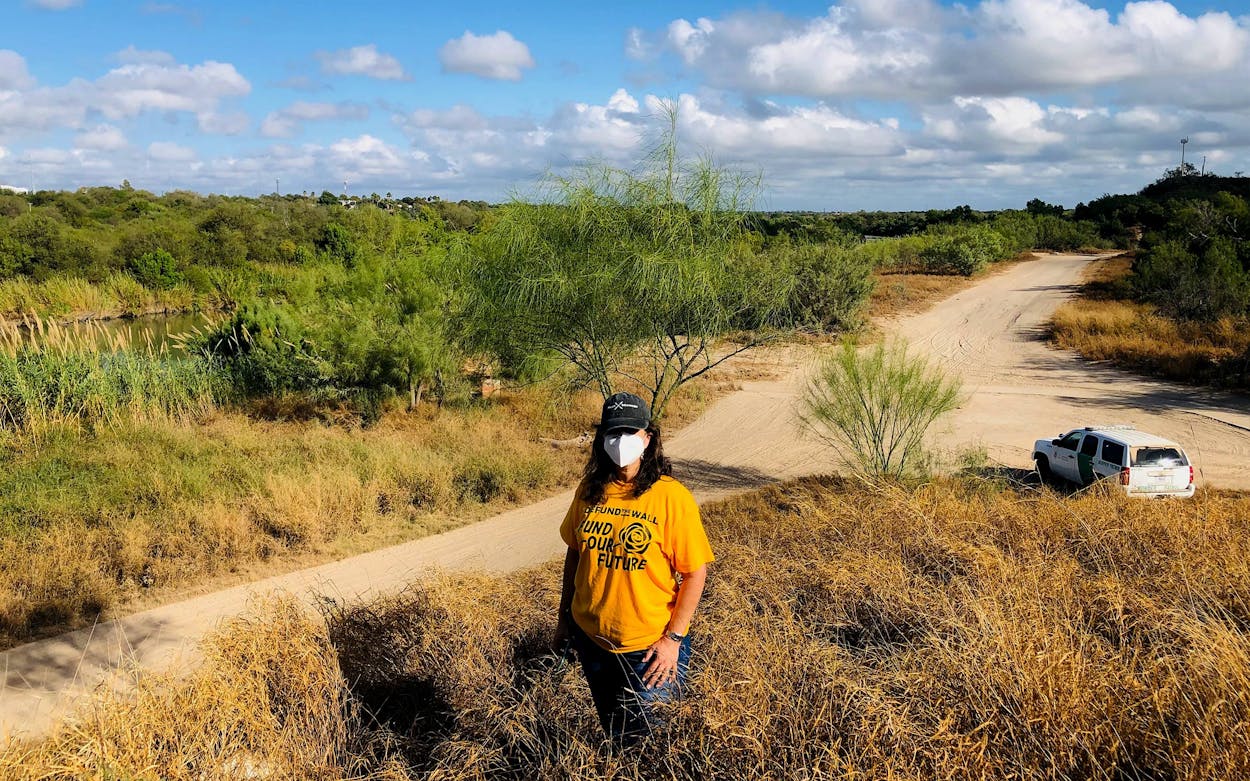The Cigarroa family’s rancho is about fifteen miles south of Laredo, its gated entrance easily missed by anyone barreling down U.S. 83. Once inside, visitors follow a dirt road that slopes gently upward, cutting through a dusty tract of South Texas brush country covered in prickly pear cactus and gouged by arroyos. When the road abruptly ends a mile or so later, visitors find themselves atop a bluff that affords expansive views of the landscape in every direction, including across the Rio Grande into Mexico.
The most impressive view, Melissa Cigarroa tells me during a recent visit, may be the one directly below, where the slow-moving river winds through a fertile-looking floodplain several football fields wide and covered in bright-green honey mesquite trees, wildflowers, and tall grasses. For years now, this lush stretch of borderland on the edge of the family’s 173-acre property has been the site of numerous family fishing trips, barbecues, and birthday parties for Cigarroa, her husband, their five kids, and their extended families. Cigarroa says the land ties them to the shared cultural heritage of Mexicans and Mexican Americans on both sides of the border. “We come out here to escape, but this is also a place that connects our family and grounds us in our history,” she said. “This is home.”
To Cigarroa’s horror, the riverfront is also one of many locations the Trump administration has spent much of the last year trying to seize for the construction of a 30-foot-tall steel border wall. With a 150-foot security zone and two service roads, the imposing barrier would entirely seal off the Cigarroa family land—not to mention much of the wildlife in the area—from the river. Despite more than a year of pressure from federal officials in the form of phone calls, emails, and court filings, Cigarroa and her husband have refused to sign legal documents that would allow the government “right of entry” to survey the property, a crucial first step in the eminent domain process. Like many landowners fighting to maintain control of their land in South Texas, her family’s plan was to hang on until November, when she hoped a Biden victory would deflate efforts to construct the border wall and prompt government lawyers to drop their lawsuit seeking access to the family’s property. But in recent weeks, she and other landowners in Webb County and neighboring Zapata say, the opposite has happened.
“The government is trying to stuff as much of the wall onto our land as possible in the final two months that they can—and it won’t even be a complete wall!” said Cigarroa. “These are ordinary small landowners they’re targeting. It’s just so destructive and craven.”
Though Biden has signaled his intention to halt border wall construction, the Trump administration has only accelerated its campaign to finish the structure. This year alone, the government has filed at least 120 lawsuits to advance the wall from Brownsville to the Laredo area, according to the Texas Civil Rights Project, a nonprofit representing landowners being sued by the government. November alone had the second-highest number of wall-related filings in the last three years, said Ricky Garza, a TCRP staff attorney.
In the Laredo area—where the government has signed four contracts this year to build about seventy miles of wall—some landowners have reported a flurry of activity. Because property owners ultimately have few tools to stop the government from seizing land, the legal fights typically revolve around the amount of compensation. But the government has several logistical and legal hurdles to clear before the end game. First, it must get permission to enter a property and survey the land, a step that many landowners have been fighting in court for much of the past year. Without that permission, the government is forced to sue landowners, slowing the process considerably as both parties spar in court.
Lately, those battles have been intensifying outside of court as well. Landowners report that contractors have been coming onto border property without permission and government-issued legal documents have been flooding their mailboxes. In other instances, federal officials have verbally harassed landowners, their lawyers say, pestering them with threats of lawsuits for refusing to sign papers giving the government access to their lands. Even landowners who have reluctantly agreed to work with the government have been subjected to intense pressure. Ricardo de Anda, a lawyer representing five Laredo-area property owners, said the government’s heightened campaign in recent weeks amounts to “bullying.” “They’re asking you to give up your property rights and telling you that if you don’t sign they’ll sue you and take you to federal court, which is unpleasant to say the least and, in many cases, frightening,” he said.

“Sadly, we expect dozens of miles of border wall to be completed here in South Texas, even before Inauguration Day,” Garza added. “Nobody should feel relief until the construction is stopped in its tracks, the lawsuits dismissed, and all the border walls come down.”
Some activists have begun preparing to step in front of bulldozers should they arrive, though most landowners are focused on a drag-it-out legal strategy. Landowners and their lawyers are holding emergency meetings over Zoom to map out last-ditch gambits in court—the final showdown in what has become a years-long war of attrition. The pandemic has only served to intensify that struggle for those living in Webb County, making it even more difficult to meet with lawyers or coordinate with relatives to discuss land appraisals or legal strategy in one of the hardest-hit counties in the state. Fighting the government is not only stressful but expensive, leaving some landowners with thousands of dollars worth of legal bills.
“There’s very little hope of actually winning these right-of-entry cases because the government is essentially saying, ‘We just want to see your land,’ and federal courts have generally been sympathetic to that argument,” said Cigarroa, who estimates that her family has spent more than $10,000 fighting the government over the last year. “We’re counting down the days until inauguration,” Cigarroa added. “We think we can hold on, but keeping our land could come down to the wire.”
The push to build is just as aggressive, and even further along, in the Rio Grande Valley, a few counties downriver. There, new barriers have been built and the government has moved to seize ancestral lands and come close to destroying the world-renowned Salineño Wildlife Preserve. But unlike the Valley, where long stretches of border wall were constructed during the Bush and Obama administrations, Laredo has been spared, except for some ten-foot fencing at Laredo College that Border Patrol officials have labeled “aesthetic.” To date, contracts worth more than $1 billion have been awarded for the development of 71 miles of riverfront property in Webb and Zapata counties, according to the No Border Wall Coalition, a group of local landowners who have banded together to fight construction.
The U.S. Department of Homeland Security has yet to confiscate any of the private property it has filed condemnation suits to acquire. Even so, federal officials have brought in four extra assistant U.S. attorneys to work on condemnation cases, one of whom was recalled from retirement, according to Congressman Henry Cuellar, a Democrat from Laredo, who has been a vocal opponent of the border wall but also helped to negotiate two deals that gave the Trump administration billions in new funding for it. Cuellar said he’s been taken aback by the government’s last-second push. “They’re trying to meet the goal that the president demanded and they’re moving at full speed,” said Cuellar, the vice chairman of the House Appropriations Subcommittee on Homeland Security, which oversees border wall funding.
Even if Biden stops the wall from expanding, many landowners fear the new president will allow existing construction contracts to be completed. In 2009, a newly elected President Obama did exactly that, allowing contracts signed during the Bush administration to move forward. The Obama administration would eventually construct more than 130 miles of new border wall, largely during the president’s first year in office, according to the Associated Press. Though Cuellar and other prominent South Texas Democrats are calling on the incoming administration to terminate construction contracts, landowners realize they remain vulnerable to the whims of the new president. “The fear is that the Trump wall becomes the Biden wall,’ said de Anda, whose 184-acre ranch north of Laredo could be sliced up by a fence. “Stripped down to its bare essentials,” it’s basically just big government taking Texas land.”

After visiting with Cigarroa, I drove twenty minutes north to the edge of El Azteca, a tight-knit, historic neighborhood east of downtown Laredo overlooking the Rio Grande, to meet up with Juan Ruiz. A field organizer with the Rio Grande International Study Center, an environmental nonprofit based in Laredo, Ruiz has spent the last few months going door-to-door handing out flyers to his neighbors with information about how the proposed border wall would harm the neighborhood.
Though some of the larger landowners around Laredo have been able to shoulder the financial burden of fighting the government, others have a limited ability to fight. That’s especially true in this zip code, where the average household income is just over $23,000. Despite being home to historic properties that date to the 1870s, the neighborhood has been subjected to mass demolitions before. To construct I-35 and the nearby international border checkpoint, authorities demolished thirteen city blocks between downtown and El Azteca in the 1970s, according to Preservation Texas. Forty years later, this was one of the first areas in Laredo that the government targeted for seizure for the wall, a reality that doesn’t surprise Ruiz. “If your goal is to build this wall, you’re going to target the most marginalized people first so that you can get them out of the way and then go against the people who really have the resources to oppose you,” he said.
When the government approached dozens of landowners here about a year ago, Ruiz said, many signed documents granting right of entry. Some didn’t understand what they were signing, Ruiz said, and others were misled by government officials who downplayed the documents’ importance, implying that their signature was only needed to collect soil samples for a potential wall that may never be built. That ambiguous messaging may partly explain why, in his attempts to organize residents for a legal fight against the wall, Ruiz has faced another equally challenging obstacle: “border wall denialism.” Many have grown numb to the idea of a fence ever coming to Laredo, viewing it as another round of empty bluster. “Even though the wall contracts are signed and the government is moving very quickly, many people here assume that it’s still just rhetoric,” Ruiz said as he stood a few yards away from a dusty yard where soil samples had already been taken. “People just assume that, especially with Biden’s election, it’s just going to go away.”

The next day, a few miles down the river, I met up again with Cigarroa at a vacant two-story home on a hill overlooking the Rio Grande on the south side of Laredo. Under a plan developed by a group of city leaders and environmentalists, the verdant fifty-acre property was to be turned into a nature center, Cigarroa explains, complete with public education events and kayak rentals on the river—the showpiece of a larger campaign to help Laredo embrace the Rio Grande instead of treating it like a forbidden barrier. Instead, construction has yet to begin and the city has allowed the federal government to begin surveying the quiet riverfront property. A few minutes after we arrive, a youngish-looking Border Patrol agent in a white and green SUV pulls up alongside us, looking confused.
“Are you guys with the surveyors?” he asks, sizing up Cigarroa’s Ford F-150 pickup truck. “We’re expecting surveyors today.”
After telling the agent that we weren’t contractors, a hint of offense in her voice, Cigarroa turned to me, looked at the ground and began to shake her head.
“I can’t believe it’s already started,” she said to herself. “The wall is on its way.”
- More About:
- Politics & Policy
- Border Wall
- Laredo








